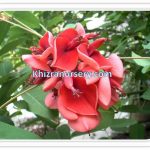Magnolia grandiflora Trees
Magnolia grandifolia (Magnoliaceae) is an evergreen tree that grows up to 10 meters while in some countries it may reaches up to 30 meters tall and 1.8 meters in diameter. It is commonly known as Southern Magnolia or Bull bay. It is native to coastal plains of Southern United States but it is widely distributed beyond its natural range. Their leaves are 10-20 cm in length, alternate, simple, oval-oblong in shape, leathery, stiff and shiny. The bark is gray to brown, smooth but becomes slightly scaly when mature. The flowers are very fragrantwith 6 to 12 white creamy petals. The numerous carpels are arranged spirally in a cone shape in the center of the flower and below which many stamens are arranged similarly. The flowers appears on stout hairy stalk during late spring and early summer. The fruits are cylindrical cones, 7-10 cm long, purplish in colour but turns rusty brown on maturity. The fruit matured in October to November and contains 1-2 fleshy scarlet coated seeds which are shiny and bright red in colour. The Magnolia flower is the official flower of Louisiana and Magnolia treeis the official tree of Mississippi.Its flowers are generally associated with dignity, nobility, perseverance and a love of nature while the tree is a symbol of magnificence because of its enormous flowers and impressive appearance.
Landscaping Ideas For Magnolia grandiflora trees
Magnolia grandiflora is widely planted as ornamental tree because of its showy fragrant flowers and evergreen leaves. It is generally planted for shade in yards, gardens, river sides and long streets.
How to propagate Magnolia grandiflora trees
- Magnolia grandiflora can be propagated through seeds.
- The seeds are sown as soon as they are ripen.
- The seeds kept in store should be sown in late winter in a cold frame.
- They usually germinates in spring and take 18 months for sprouting seedlings.
- The seedlings should be kept in light shade or greenhouse at least for first winter.
- They should be transferred in individual pots when they become enough to handle.
- They can be planted out in their permanent position when they are more than 15 cm tall.
- Magnolia can be also propagated by branches through layering.
How to take care Of Magnolia grandiflora trees
- Magnolia grandiflora needs full sunlight and partial shade.
- It prefers loose, moist and fertile soil with high salt content.
- It is very sensitive to its depth of planting because of it shallow competitive root system.
- Its growth will stunted when planted in compact, heavy and poorly drained soil.
- It tolerate strong winds but not maritime exposure.
- It drops its foliage throughout the year and leaving its leaves litter underneath its branches.
- The plant normally do not need pruning but if necessary, best time to prune is July.
- The young terminal shoots are susceptible to a small beetle called “Bostrichid” that damages tree canopy by infestation.
Uses of Magnolia grandiflora
- Magnolia grandiflora seeds are consumed by many species of birds and small mammals like squirrels etc.
- The leathery leaves and flowers are used for decoration purposes and floral arrangements.
- The wood has limited uses but may use in baskets, woodenware, veneer, cabinets, paneling, furniture and as fuel.
- The bark is used as stimulant, tonic, diaphoretic and cured rheumatism and malaria.
- The bark decoctions are used to wash for sores, remove itching and bath to treat dropsy and prickly heat.
- It also used to reduce blood pressure and accelerate respiration.
- The flowers are used as spice, condiment, in prickles and to enhance food flavor.
- The flowers are processed to obtain essential oil.
- Timber of magnolia is also used in furniture industry.
Phytochemical Constituents of Magnolia grandiflora
Magnolia grandiflora contains active phytochemical constituents such as Magnolol and honokiol which exhibited antioxidant, antifungal and antibacterial properties. The leaves contains sesquiterpene lactones and coumarins.











Reviews
There are no reviews yet.